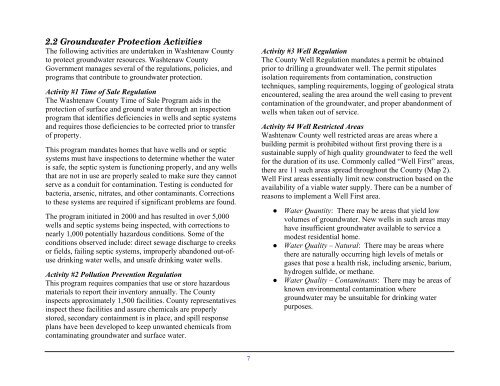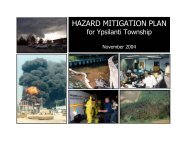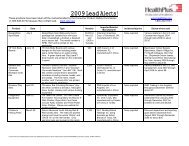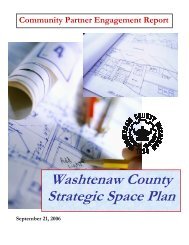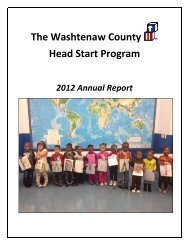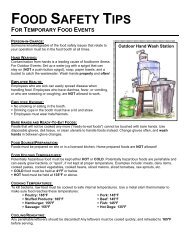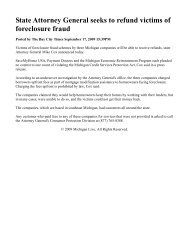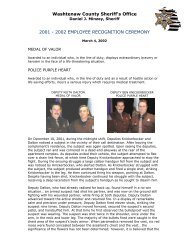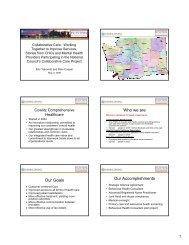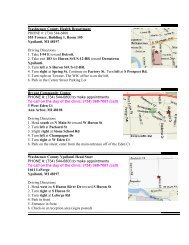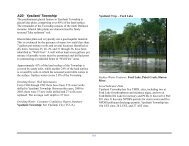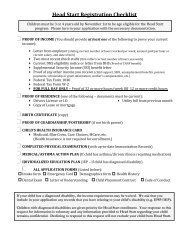Water Protection Activities in Washtenaw County
Water Protection Activities in Washtenaw County
Water Protection Activities in Washtenaw County
You also want an ePaper? Increase the reach of your titles
YUMPU automatically turns print PDFs into web optimized ePapers that Google loves.
2.2 Groundwater <strong>Protection</strong> <strong>Activities</strong><br />
The follow<strong>in</strong>g activities are undertaken <strong>in</strong> <strong>Washtenaw</strong> <strong>County</strong><br />
to protect groundwater resources. <strong>Washtenaw</strong> <strong>County</strong><br />
Government manages several of the regulations, policies, and<br />
programs that contribute to groundwater protection.<br />
Activity #1 Time of Sale Regulation<br />
The <strong>Washtenaw</strong> <strong>County</strong> Time of Sale Program aids <strong>in</strong> the<br />
protection of surface and ground water through an <strong>in</strong>spection<br />
program that identifies deficiencies <strong>in</strong> wells and septic systems<br />
and requires those deficiencies to be corrected prior to transfer<br />
of property.<br />
This program mandates homes that have wells and or septic<br />
systems must have <strong>in</strong>spections to determ<strong>in</strong>e whether the water<br />
is safe, the septic system is function<strong>in</strong>g properly, and any wells<br />
that are not <strong>in</strong> use are properly sealed to make sure they cannot<br />
serve as a conduit for contam<strong>in</strong>ation. Test<strong>in</strong>g is conducted for<br />
bacteria, arsenic, nitrates, and other contam<strong>in</strong>ants. Corrections<br />
to these systems are required if significant problems are found.<br />
The program <strong>in</strong>itiated <strong>in</strong> 2000 and has resulted <strong>in</strong> over 5,000<br />
wells and septic systems be<strong>in</strong>g <strong>in</strong>spected, with corrections to<br />
nearly 1,000 potentially hazardous conditions. Some of the<br />
conditions observed <strong>in</strong>clude: direct sewage discharge to creeks<br />
or fields, fail<strong>in</strong>g septic systems, improperly abandoned out-ofuse<br />
dr<strong>in</strong>k<strong>in</strong>g water wells, and unsafe dr<strong>in</strong>k<strong>in</strong>g water wells.<br />
Activity #2 Pollution Prevention Regulation<br />
This program requires companies that use or store hazardous<br />
materials to report their <strong>in</strong>ventory annually. The <strong>County</strong><br />
<strong>in</strong>spects approximately 1,500 facilities. <strong>County</strong> representatives<br />
<strong>in</strong>spect these facilities and assure chemicals are properly<br />
stored, secondary conta<strong>in</strong>ment is <strong>in</strong> place, and spill response<br />
plans have been developed to keep unwanted chemicals from<br />
contam<strong>in</strong>at<strong>in</strong>g groundwater and surface water.<br />
7<br />
Activity #3 Well Regulation<br />
The <strong>County</strong> Well Regulation mandates a permit be obta<strong>in</strong>ed<br />
prior to drill<strong>in</strong>g a groundwater well. The permit stipulates<br />
isolation requirements from contam<strong>in</strong>ation, construction<br />
techniques, sampl<strong>in</strong>g requirements, logg<strong>in</strong>g of geological strata<br />
encountered, seal<strong>in</strong>g the area around the well cas<strong>in</strong>g to prevent<br />
contam<strong>in</strong>ation of the groundwater, and proper abandonment of<br />
wells when taken out of service.<br />
Activity #4 Well Restricted Areas<br />
<strong>Washtenaw</strong> <strong>County</strong> well restricted areas are areas where a<br />
build<strong>in</strong>g permit is prohibited without first prov<strong>in</strong>g there is a<br />
susta<strong>in</strong>able supply of high quality groundwater to feed the well<br />
for the duration of its use. Commonly called “Well First” areas,<br />
there are 11 such areas spread throughout the <strong>County</strong> (Map 2).<br />
Well First areas essentially limit new construction based on the<br />
availability of a viable water supply. There can be a number of<br />
reasons to implement a Well First area.<br />
● <strong>Water</strong> Quantity: There may be areas that yield low<br />
volumes of groundwater. New wells <strong>in</strong> such areas may<br />
have <strong>in</strong>sufficient groundwater available to service a<br />
modest residential home.<br />
● <strong>Water</strong> Quality – Natural: There may be areas where<br />
there are naturally occurr<strong>in</strong>g high levels of metals or<br />
gases that pose a health risk, <strong>in</strong>clud<strong>in</strong>g arsenic, barium,<br />
hydrogen sulfide, or methane.<br />
● <strong>Water</strong> Quality – Contam<strong>in</strong>ants: There may be areas of<br />
known environmental contam<strong>in</strong>ation where<br />
groundwater may be unsuitable for dr<strong>in</strong>k<strong>in</strong>g water<br />
purposes.


